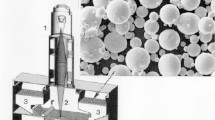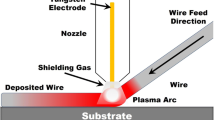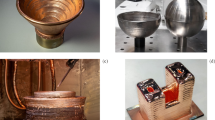Abstract
The fabrication of multi-material structures using Ti–6Al–4V and copper was explored with the additive manufacturing (AM) technology of electron beam melting (EBM). A new method was developed that included multiple build sequences to accommodate both materials. The process was enabled by machining a start plate so that the parts built with the first material could be press fit into the plate, providing a flat surface on which the second material fabrication would occur. This method provided the ability to fabricate simple multiple metallic material components built in the Z and X directions [1]. Registration of the electron beam was performed manually resulting in slight misalignment for the shift of diameters of specimens built in the Z direction, and along the width and length for specimens built in the X direction. Microstructures observed and hardness values measured for copper and Ti–6Al–4V were different to those observed in normally fabricated EBM parts. These observations might be explained by the different processing conditions required for multi-material fabrication in contrast to the regular EBM process where parts are built in a single machine run. The hardness profiles for as-fabricated and HIPed multi-material parts depicted an increase in hardness for both materials close to the interface with values leveling off to those of single material EBM fabricated parts as measurements proceeded away from the interface. As the benefits of EBM processing are exploited, the method introduced in this research can have profound implications in many technological applications including metal extraction, energy production and for the repair of metallic components.
Similar content being viewed by others
References
American Society for Testing and Materials, Standard F2921-11 (2012) Standard Terminology for Additive Manufacturing–Coordinate Systems and Test Methodologies. ASTM International, West Conshohocken. doi:10.1520/F2921-11
American Society for Testing and Materials, Standard F2792-12a (2012) Standard Terminology for Additive Manufacturing Technologies. ASTM International, West Conshohocken. doi:10.1520/F2792-12A
Wicker R, MacDonald E (2012) Multi-material, multi-technology stereolithography. Virtual and Physical Prototyping 7(3):181–194
Choi J, Kim H, Wicker R (2011) Multi-material stereolithography. Journal of Materials Processing Technology 211:318–328
Choi J, MacDonald E, Wicker R (2010) Multi-material microstereolithography. International Journal of Advanced Manufacturing Technology 49:543–551
Arcaute K, Mann B, Wicker R (2010) Stereolithography of spatially controlled multi-material bioactive poly(ethylene glycol) scaffolds. Acta Biomaterialia 6:1047–1054
Lopes A, MacDonald E, Wicker R (2012) Integrating stereolithography and direct print technologies for 3D structural electronics fabrication. Rapid Prototyping Journal 18:129–143
Sigmarsson H, Kinzel E, Chappell W, Xu X (2006) Selective laser sintering of multilayer, multimaterial circuit components. IEEE MTT-S International Microwave Symposium Digest June 2006:1788–1791
Chung H, Das S (2008) Functionally graded nylon-11/silica nanocomposites produced by selective laser sintering. Materials Science and Engineering A-487:251–257
Griffith ML, Harwell LD, Romero JT (1997) Multi-material processing by LENS™. Working paper. Sandia National Laboratories
Balla V, Xue W, Bose S, Bandyopadhyay A (2008) Functionally graded Co–Cr–Mo coating on Ti–6Al–4V alloy structures. Acta Biomaterialia 4:697–706
Balla V, Bandyopadhyay P, Bose S, Bandyipadhyay A (2007) Compositionally graded yttria-stabilized zirconia coating on stainless steel using laser engineered net shaping (LENSTM). Scripta Materialia 57:861–864
Obielodan J, Stucker B (2010) Dual-material minimum weight structures fabrication using ultrasonic consolidation. In 21st Annual International Solid Freeform Fabrication Symposium, August 2010: 48–81
Sun Z, Karppi R (1996) The application of electron beam welding for the joining of dissimilar metals: an overview. Journal of Materials Processing Technology 39:257–267
Obielodan J, Ceylan A, Murr L, Stucker B (2010) Multi-material bonding in ultrasonic consolidation. Rapid Prototyping Journal 16:180–188
Murr L, Esquivel E, Quinones S, Gaytan S, Lopez M, Martinez E, Medina F, Hernandez D, Martinez E, Martinez J, Stafford S, Brown D, Hoppe T, Meyers W, Lindhe U, Wicker R (2009) Microstructures and mechanical properties of electron beam-rapid manufactured Ti–6Al–4V biomedical prototypes compared to wrought Ti–6Al–4V. Materials characterization 60:96–105
Ramirez D, Murr L, Martinez E, Hernandez D, Martinez J, Machado B, Medina F, Frigola P, Wicker R (2011) Novel precipitate-microstructural architecture developed in the fabrication of solid copper components by additive manufacturing using electron beam melting. Acta Materialia 59:4088–4099
Thijs L, Verhaeghe F, Craeghs T, Humbeeck J, Kruth J (2010) A study of the microstructural evolution during selective laser melting of Ti–6Al–4V. Acta Materialia 58:3303–3312
MatWeb (2013) Material Property Data. Ti-6Al-4V (Grade 5), Annealed Bar. http://www.matweb.com/search/DataSheet.aspx?MatGUID=10d463eb3d3d4ff48fc57e0ad1037434. Accessed 20 January 2013
MatWeb (2013) Material Property Data. Copper, Cu: Annealed. http://matweb.com/search/DataSheet.aspx?MatGUID=9aebe83845c04c1db5126fada6f76f7e. Accessed 20 January 2013
Rosa J, Robin A, Silva M, Baldan C, Peres M (2009) Electrodeposition of copper on titanium wires: Taguchi experimental design approach. Journal of Materials Processing Technology 209:1181–1188
Demidenko L, Onatskaya N (2008) Solid-state welding of tubular joints of titanium and copper with application of electrohydropulse loading. Surface Engineering and Applied Electrochemistry 44:245–247
Kline G, (1983) Titanium clad copper electrode and method for making. U.S. Patent No. 4,411,762
Oberg E, Jones F, Horton H, Ryffel H (1996) Machinery's handbook, 25th Edition. New York, USA
Engineers Edge (2013) Dowel Pin Tolerance Chart – ASME Y14.5-2009. http://www.engineersedge.com/dowel_pin.htm. Accessed 6 March 2013
Froes F, Mashl S, Moxson V, Hebeisen J, Duz V (2004) The technologies of titanium powder metallurgy. JOM: 46–48
Teodorescu G (2007) Radiative emissivity of metals and oxidized metals at high temperature. Dissertation, Auburn University
Arcam A2 System Technical Data (2013) http://www.arcam.com/CommonResources/Files/www.arcam.com/Documents/Products/Arcam-A2.pdf. Accessed 3 March 2013
Versnyder F, Shank M (1970) The development of columnar grain and single crystal high temperature materials through directional solidification. Materials Science and Engineering 6:213–247
Field D, Bradford L, Nowell M, Lillo T (2007) The role of annealing twins during recrystallization of Cu. Acta Materialia 55:4233–4241
Koike M, Martinez K, Guo L, Chahine G, Kovacevic R, Okabe T (2011) Evaluation of titanium alloy fabricated using electron beam melting system for dental applications. Journal of Materials Processing Technology 211:1400–1408
Karlsson J, Snis A, Engqvist H, Lausmaa J (2013) Characterization and comparison of materials produced by Electron Beam Melting (EBM) of two different Ti–6Al–4V powder fractions. Journal of Materials Processing Technology 213:2109–2118
Bolzoni L, Montealegre I, Ruiz-Navas E, Gordo E (2012) Microstructural evolution and mechanical properties of the Ti–6Al–4V alloy produced by vacuum hot-pressing. Materials Science and Engineering A-546:189–197
Nesterenko V, Goldsmith W, Indrakanti S, Gu Y (2003) Response of hot isostatically pressed Ti–6Al–4V targets to normal impact by conical and blunt projectiles. International Journal of Impact Engineering 28:137–160
Srivatsan T, Ravi B, Naruka A, Petraroli M, Kalyanamaran R, Sudarshan T (2002) Influence of consolidation parameters on the microstructure and hardness of bulk copper samples made from nanopowders. Materials and Design 23:291–296
Author information
Authors and Affiliations
Corresponding author
Rights and permissions
About this article
Cite this article
Terrazas, C.A., Gaytan, S.M., Rodriguez, E. et al. Multi-material metallic structure fabrication using electron beam melting. Int J Adv Manuf Technol 71, 33–45 (2014). https://doi.org/10.1007/s00170-013-5449-0
Received:
Accepted:
Published:
Issue Date:
DOI: https://doi.org/10.1007/s00170-013-5449-0




